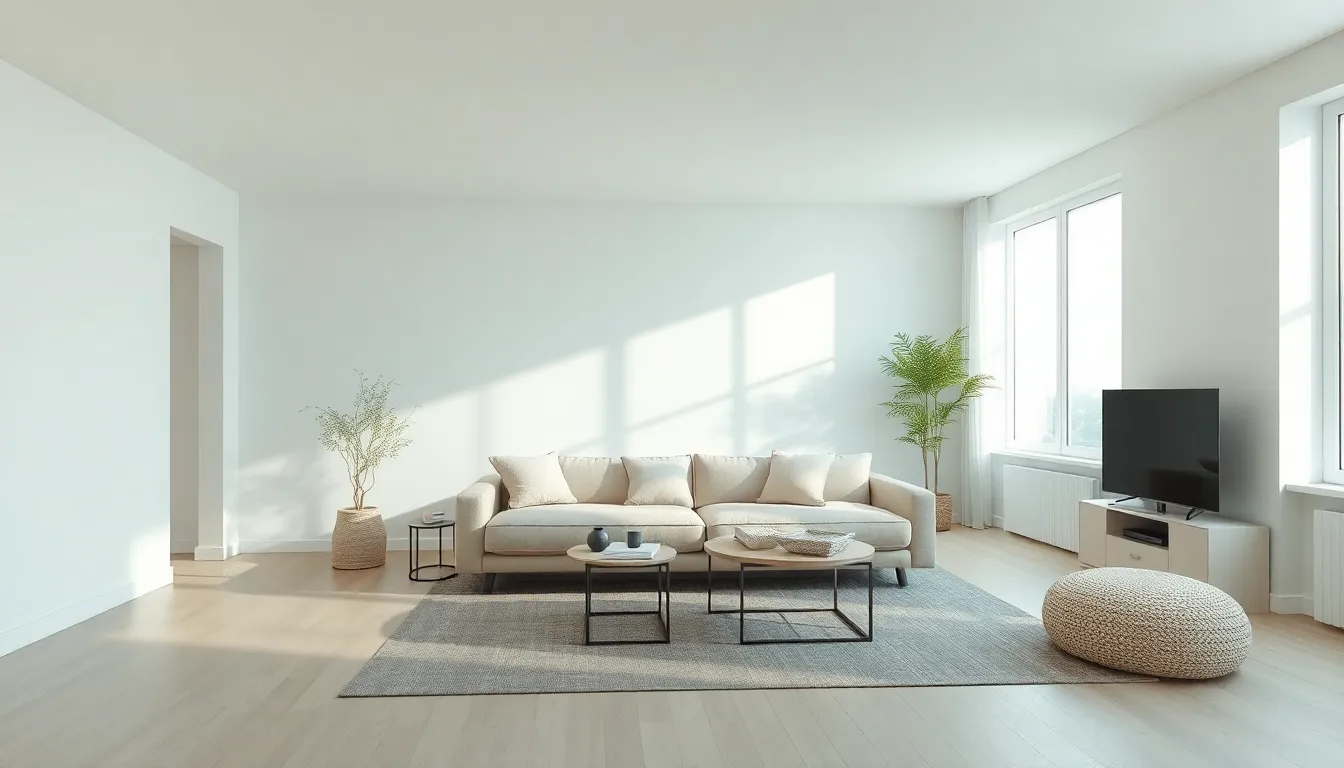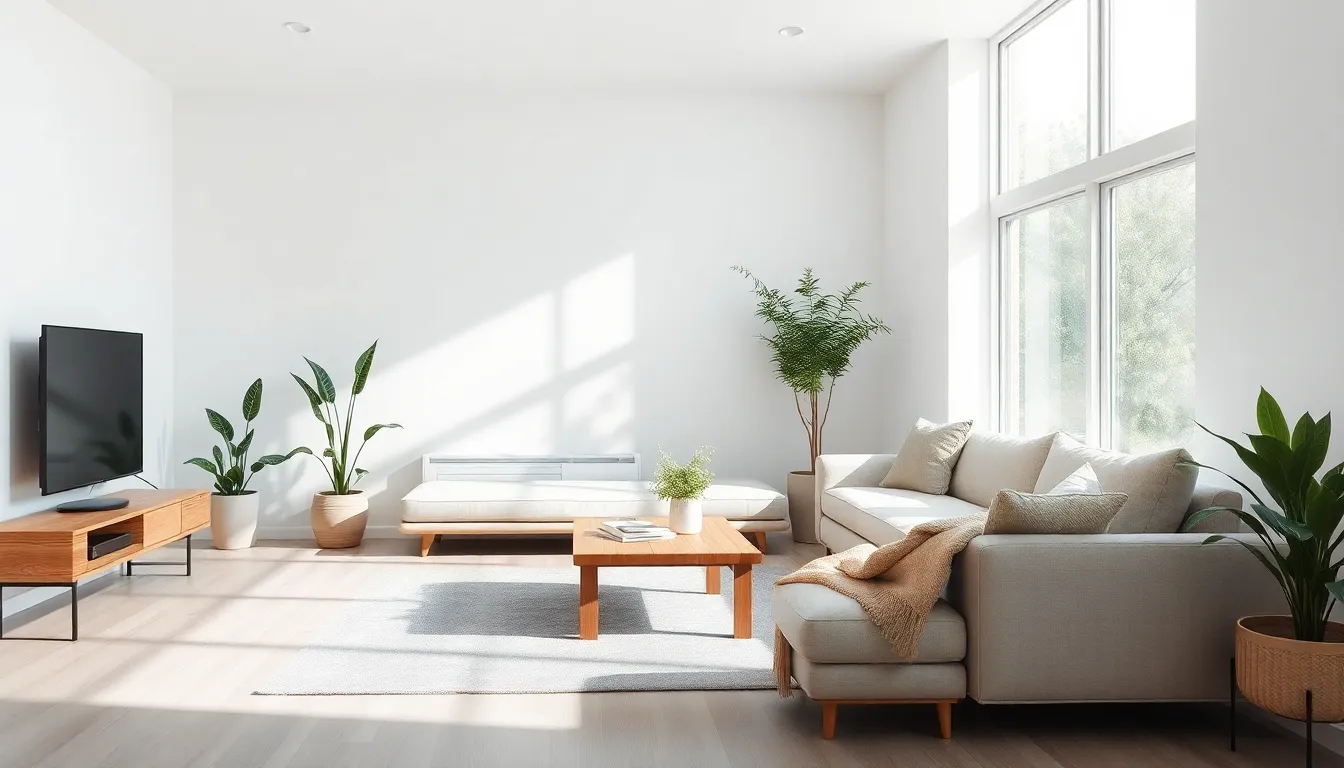In a world overflowing with clutter and chaos, minimalist interiors offer a refreshing escape. Imagine walking into a space where every item has a purpose and a place. It’s like stepping into a serene oasis where your mind can finally breathe. Who wouldn’t want that?
Minimalism isn’t just about tossing out the excess; it’s a lifestyle choice that emphasizes simplicity and functionality. By focusing on clean lines and neutral palettes, minimalist design transforms homes into sanctuaries of peace. Plus, less stuff means less time spent cleaning—who wouldn’t want to swap a Saturday of dusting for a day at the beach?
Dive into the world of minimalist interiors and discover how this stylish approach can elevate your living space while keeping your sanity intact. Get ready to embrace the beauty of less and find out why simplicity is the ultimate sophistication.
Table of Contents
ToggleOverview of Minimalist Interiors
Minimalist interiors focus on simplicity and functionality. Design elements prioritize clean lines, open spaces, and a limited color palette. Each piece within these spaces contributes meaningfully to the overall aesthetic, embodying ‘less is more.’ Unnecessary items get eliminated, creating a clutter-free environment.
Furniture choices often highlight sleek designs and natural materials. Common materials include wood, metal, and glass, which enhance the airy feeling of minimalist interiors. Lighting fixtures maintain a streamlined appearance, contributing to the serene atmosphere.
Spatial arrangement plays a crucial role in minimalist design. Open floor plans invite light and encourage fluid movement throughout the space. Layout choices maximize usability while minimizing distractions. Storage solutions stay hidden or integrated, reinforcing the tidy appearance.
In minimalist kitchens, functionality remains vital. Streamlined cabinetry and uncomplicated countertops create a practical yet aesthetically pleasing environment. Simple hardware promotes a clean look. For living areas, fewer decorative elements lead to focal points that draw the eye without overwhelming the senses.
Color schemes often consist of neutral shades paired with occasional pops of color. These choices enhance tranquility and calmness, supporting the overall goal of creating a peaceful sanctuary. Accessories, when present, typically serve a dual purpose, merging beauty and practicality seamlessly.
The psychological benefits of minimalist interiors cannot get overstated. Such environments reduce stress and foster mental clarity. By eliminating excess, individuals find space to breathe, reflect, and rejuvenate. Minimalism transforms living spaces into sanctuaries that nurture well-being.
Key Principles of Minimalist Design

Minimalist design relies on key principles that create harmonious living spaces. These principles emphasize simplicity and functionality, showcasing how less can truly be more.
Simplicity and Functionality
Simplicity defines minimalist interiors. Clean lines and unembellished forms dominate the design, making every item count. Functionality complements simplicity, ensuring each piece serves a purpose. For instance, multifunctional furniture like a sofa bed maximizes usability while minimizing clutter. Accessories, chosen for their practical benefits, enhance the space without overwhelming it. Each element harmonizes to promote a serene environment, supporting the minimalist philosophy of intentional living. By prioritizing essential items, clutter dissipates, establishing a calming backdrop for everyday life.
Open Spaces and Light
Open spaces create a sense of freedom and tranquility within minimalist interiors. These layouts enhance the flow of light, contributing to an airy atmosphere. High ceilings and large windows invite natural illumination, fostering warmth and connection to the outdoors. Light colors enhance this effect, reflecting brightness and expanding perceived space. Strategic furniture placement further enhances usability while maintaining openness. The arrangement promotes ease of movement, allowing individuals to navigate effortlessly. In kitchens and living areas, this principle invites creativity and relaxation, reinforcing the joy of simple living.
Color Palette and Materials
Minimalist interiors rely on carefully chosen color palettes and materials to enhance their aesthetic appeal. Color selection emphasizes tranquility and simplicity.
Neutral Tones
Neutral tones dominate minimalist designs. Shades of white, beige, gray, and taupe create a cohesive environment that promotes relaxation. These colors reflect light, making spaces feel larger and more open. They allow for easy coordination with other elements in the interior. A neutral base sets the stage for occasional pops of color through accessories, artwork, or plants, ensuring a balanced yet engaging look. In turn, these subtle contrasts highlight the beauty of simplicity while maintaining the overall minimal aesthetic.
Natural Elements
Natural materials play a vital role in minimalist interiors. Wood, stone, and glass contribute warmth and texture, creating inviting spaces. Wood adds character and warmth, while stone offers a robust, grounding quality. Glass introduces transparency, enhancing light flow and maintaining openness. These elements foster a connection to nature, essential for creating a serene atmosphere. By incorporating these natural materials, designers can create visually appealing environments that evoke calmness and stability, aligning perfectly with minimalist principles.
Furnishing in Minimalist Interiors
Furnishing in minimalist interiors focuses on simplicity and purpose. Selecting essential pieces enhances functionality while maintaining a calm aesthetic.
Essential Furniture Pieces
Essential furniture pieces include sofas, tables, and chairs that possess clean lines and understated designs. These items often feature neutral colors and natural materials, contributing to an airy feeling. A low-profile sofa complements a spacious layout, while a simple wooden coffee table serves as a focal point without overwhelming the space. Dining tables made of glass or light-colored wood promote a sense of openness, inviting gatherings without excess decoration. Each piece plays its part, ensuring that every element enhances the overall atmosphere while remaining practical.
Multi-Functional Designs
Multi-functional designs maximize usability in minimalist interiors. Furniture that combines different functions, like a couch that transforms into a bed, caters to limited space needs. Nesting tables provide flexibility, allowing for easy adjustments based on gatherings or daily activities. Additionally, storage ottomans conceal clutter while offering extra seating, optimizing available space. Investing in pieces that perform multiple roles simplifies decor while maintaining elegance. Prioritizing multi-functional designs fosters a serene environment that aligns with minimalist ideals.
Benefits of Minimalist Interiors
Minimalist interiors offer numerous advantages that enhance daily living. Reducing visual clutter promotes mental clarity, allowing individuals to focus on what’s essential. A serene environment fosters relaxation, contributing to overall well-being. Individuals often find that minimalism decreases cleaning time, freeing up hours for more enjoyable activities.
Creating spaces with functionality leads to greater efficiency. Choosing multi-functional furniture means maximizing utility without compromising style. Natural light floods open areas, enhancing mood and creating an airy atmosphere. A limited color palette, featuring neutrals, generates a cohesive look that makes spaces feel larger and more inviting.
Design simplifies decision-making, as fewer decorative elements reduce distractions. A thoughtfully arranged layout encourages ease of movement, making daily tasks more enjoyable. Stress often decreases when surrounded by a calm and organized space, improving quality of life.
Natural materials enhance the appeal of minimalist design by adding warmth and texture. Wood, stone, and glass resonate with nature, grounding interiors in a comforting way. The connection to the outdoors inspires a sense of tranquility and peace.
Accessibility plays a critical role, as minimalist spaces often promote inclusivity. Thoughtful design can accommodate various needs, making environments welcoming for everyone. Embracing minimalism translates into a lifestyle choice that emphasizes ease, comfort, and intentionally curated spaces.
Overall, minimalist interiors provide a stylish, functional, and peaceful atmosphere that enhances both mental and emotional well-being.
Embracing minimalist interiors can transform any living space into a tranquil haven. By prioritizing simplicity and functionality, individuals can create environments that promote mental clarity and reduce stress. The thoughtful selection of colors and materials enhances the overall aesthetic while fostering a sense of connection to nature.
With open spaces and strategic furniture placement, minimalist design encourages ease of movement and accessibility for all. This approach not only elevates the style of a home but also enhances the quality of daily life. Adopting minimalism is more than just a design choice; it’s a lifestyle that nurtures well-being and invites serenity into everyday living.




